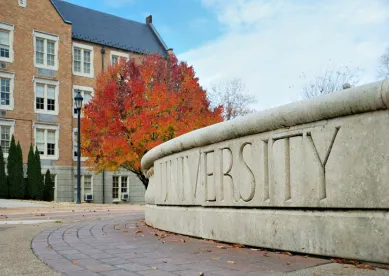On May 21, 2020, the U.S. Centers for Disease Control and Prevention (CDC) issued Considerations for Institutes of Higher Education, outlining recommendations and guidance on ways universities and colleges can safely open while helping to protect their students, faculty, staff, administrators, and community members. The CDC cautions that “[t]he more an individual interacts with others, and the longer that interaction, the higher the risk of COVID-19 spread.” Accordingly, the CDC outlined tiered risk categories for various settings on university and college campuses:
-
Lowest Risk: Virtual-only learning options, activities, and events; closure of residence halls, where feasible.
-
More Risk: Small in-person classes, activities, and events, where individuals remain six feet apart and do not share objects (e.g., staggered/rotated scheduling to accommodate smaller class sizes); residence halls are open with lowered capacity and closure of shared spaces.
-
Highest Risk: Full and regular in-person classes, activities, and events; residence halls are open at full capacity and shared spaces are available for use.
Promoting Behaviors That Reduce Spread
The CDC outlined several strategies for universities and colleges to consider to encourage behaviors that reduce the spread of COVID-19 as campuses begin to reopen (and in the event such institutions decide to offer any version of an in-person class).
Recommend and Reinforce Good Hygiene Etiquette
-
“Recommend and reinforce handwashing with soap and water for at least 20 seconds.”
-
“Encourage students, faculty, and staff to cover coughs and sneezes with a tissue or use the inside of [their] elbow[s].”
-
Dispose of used tissues in the trash and wash hands immediately.
-
Provide adequate supplies to support healthy hygiene behaviors, such as “soap, hand sanitizer containing at least 60 percent alcohol, paper towels, tissues, disinfectant wipes, cloth face coverings (as feasible), and no-touch/foot pedal trash cans.”
-
“Post signs in highly visible locations (e.g., building entrances, restrooms, dining areas) that promote [good hygiene etiquette] and describe how to stop the spread of germs.”
-
“Include messages . . . about [encouraged] behaviors that prevent [the] spread of COVID-19 when communicating with faculty, staff, and students” and publish this information on the university’s website or social media accounts.
Encourage the Use of Cloth Face Coverings
-
Encourage students, faculty, and staff to use cloth face coverings (where feasible), especially “when physical distancing is difficult.”
-
Provide information to students, faculty, and staff on “proper use, removal, and washing of cloth face coverings.”
Stay Home or Self-Isolate (When Appropriate)
-
“[E]ducate students, faculty, and staff on when they should stay home or self-isolate.”
-
“[A]ctively encourage students, faculty, and staff who have been sick with COVID-19 symptoms, tested positive for COVID-19, or have been potentially exposed to someone with COVID-19 . . . to follow CDC guidance to self-isolate or stay home.”
-
Identify a designated official/COVID-19 point of contact to whom students, faculty, and staff should report “if they become sick with COVID-19 symptoms, test positive for COVID-19, or have been exposed to someone with COVID-19 symptoms or a confirmed or suspected case.”
-
“Develop [and communicate] policies that encourage sick individuals to stay home without fear of reprisals.”
-
“Offer virtual learning and telework options, if feasible.”
Maintaining Healthy Environments
The CDC identified a series of strategies to maintain healthy campuses and mitigate COVID-19 spread, ranging from cleaning and disinfection plans to modifying classroom designs. Highlights include:
Cleaning and Disinfection Plan
-
Develop a plan and schedule increased cleaning and disinfection, particularly for frequently touched surfaces, shared equipment, and transportation vehicles. According to the CDC, frequently touched surfaces should be cleaned and disinfected “at least daily or between use[s] as much as possible.”
-
“Avoid sharing electronic devices, books, pens, and other learning aids.”
-
“Discourage sharing of items that are difficult to clean or disinfect.”
-
If objects or equipment must be shared, “clean and disinfect between [each] use.”
Modified Layouts
-
Consider changing classrooms and lab workstations to facilitate social distancing.
-
For movable desks, tables, and chairs, spread them at least six feet apart.
-
For non-movable desks, tables, and chairs, tape or block off seats and rows to “ensure six-foot distance between seats.”
-
Minimize class size by offering distant or virtual learning and move smaller classes to larger rooms.
Physical Barrier and Guides
-
In campus settings where social distancing is not possible or practicable, “install physical barriers, such as sneeze guards and partitions.”
-
Post signage encouraging social distancing and affix tape on floors or sidewalks as reminders to practice social distancing.
-
If applicable, consult the CDC’s guidance for reopening buildings after prolonged shutdown or reduced operation.
Communal Spaces
-
“Close shared spaces such as dining halls, game rooms, exercise rooms, and lounges if possible.”
-
If such spaces remain open, stagger use and restrict occupancy levels.
-
Consider “physical barriers, such as plastic flexible screens, between bathroom sinks and between beds especially when they cannot be at least [six] feet apart.”
-
For more information, consult the CDC’s guidance for shared and congregate housing.
Food Service
-
Instead of buffet or self-service stations, provide “grab-and-go options for meals” or “individually plated meals.”
-
“Use disposable food service items (e.g., utensils, dishes).”
-
If non-disposable food services items are used, provide guidance on steps to clean and safely handle such items.
Maintaining Healthy Operations
The CDC also identified strategies to maintain healthy campus operations. Highlights include:
Designate COVID-19 Point of Contact
-
As part of creating a COVID-19 response plan, “designate an administrator or office to be responsible for responding to COVID-19 concerns.”
-
Once identified, publish and distribute contact information for the COVID-19 point of contact.
Protections for Higher Risk Individuals
-
For faculty, staff, and students at higher risk for severe illness, consider telework, modified job responsibilities, or virtual learning opportunities that may limit their exposure risk.
-
Implement changes to employment and classroom policies regarding physical attendance and participation (if required).
Meetings, Gatherings, and Sporting Events
-
“Encourage telework for as many faculty and staff as possible.”
-
“Replace in-person meetings with video- or tele-conference calls whenever possible.”
-
“Provide student support services virtually, as feasible.”
-
Replace large gatherings and events with virtual meetings, where possible.
-
If not possible, promote social distancing and limit group size.
-
“Pursue options to convene sporting events and participate in sports activities in ways that reduce the risk of transmission of COVID-19 to players, families, coaches, and communities.” The CDC does not identify any specific options to consider in this regard.
Communication Systems
-
Create avenues for students, faculty, and staff to report “if they have symptoms of COVID-19, a positive test for COVID-19, or were exposed to someone with COVID-19 within the last 14 days.” In addition to employment and privacy laws, the Family Educational Rights and Privacy Act (FERPA) may be implicated by the creation of this new communication system.
Leave (Time Off) and Excused Absence Policies
-
Modify policies and practices to “enable faculty, staff, and students to stay home or self-isolate when they are sick, have been exposed, or caring for someone who is sick,” and to address return to campus and classes, if applicable, following COVID-19 illness.
Recognize Signs and Symptoms
-
“If feasible, conduct daily health checks or ask faculty, staff, and students to conduct self-checks (e.g., temperature screening and/or symptom checking).” For examples, consult the CDC’s FAQs for Businesses. State and local public health officials may also have required or suggested screening methods that affect college campuses.
Support Coping and Resilience
-
“Encourage employees and students to take breaks from watching, reading, or listening to news stories, including social media if they are feeling overwhelmed or distressed.”
-
“Promote eating healthy, exercising, getting sleep, and finding time to unwind.”
-
Post signage for the national distress hotline: 1-800-985-5990, or text TalkWithUs to 66746.
Preparing for When Someone Gets Sick
Even when colleges and universities take the necessary steps to stop the spread of germs on campus, sickness is inevitable. As such, the CDC identified strategies that colleges and universities can consider to prepare for when someone gets sick.
Advise Sick Individuals of Home Isolation Criteria
-
Encourage “[s]ick faculty, staff, or students not [to] return to [campus], or end isolation until they have met [the] CDC’s criteria to discontinue home isolation.”
Isolate and Transport Sick Individuals
-
“Immediately separate faculty, staff, and students with COVID-19 symptoms.”
-
Encourage “[i]ndividuals who are sick [to] go home or to a healthcare facility, depending on how severe their symptoms are, and follow the CDC’s guidance for caring for oneself and others who are sick.” For on-campus housing arrangements, colleges and universities should consider consulting the CDC’s guidance for shared and congregate housing.
-
“[I]dentify an isolation room, area, or building/floor . . . to separate anyone who has COVID-19 symptoms or tests positive but does not have symptoms.”
-
“Establish procedures for safely transporting [sick individuals] to their home or to a healthcare facility.”
Clean and Disinfect
-
“Close off areas used by a sick [individual].”
-
“Wait at least 24 hours before cleaning and disinfecting,” and “do not use these areas until after cleaning and disinfecting.”
Notify Health Officials and Close Contacts
-
“In accordance with applicable federal, state and local laws and regulations, [colleges and universities] should notify local health officials, faculty, staff, and students immediately of any case of COVID-19 while maintaining confidentiality in accordance with the Americans with Disabilities Act (ADA), FERPA . . . and other applicable laws and regulations.”
-
Notify “those who have had close contact with a person diagnosed with COVID-19 to stay home or in their living quarters and self-monitor for symptoms, and follow CDC guidance if symptoms develop.”
As campuses open up across the nation, colleges and universities can review these considerations in furtherance of their plans to prioritize the health and safety of their students, faculty, and staff.





 />i
/>i

